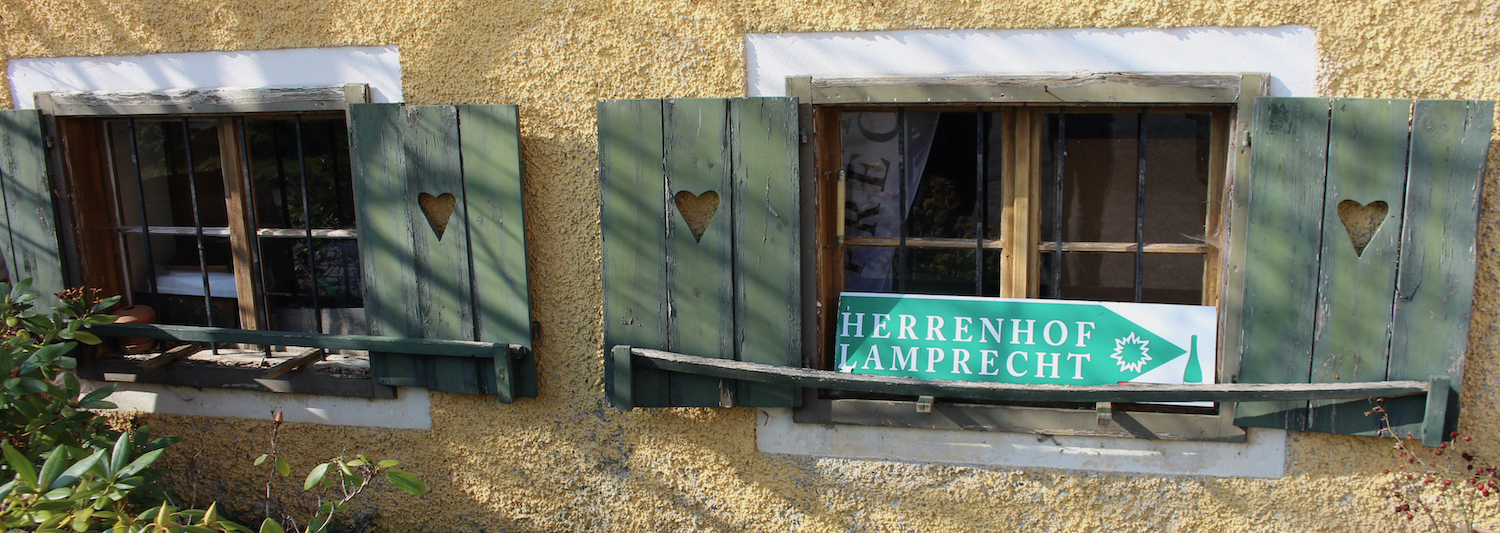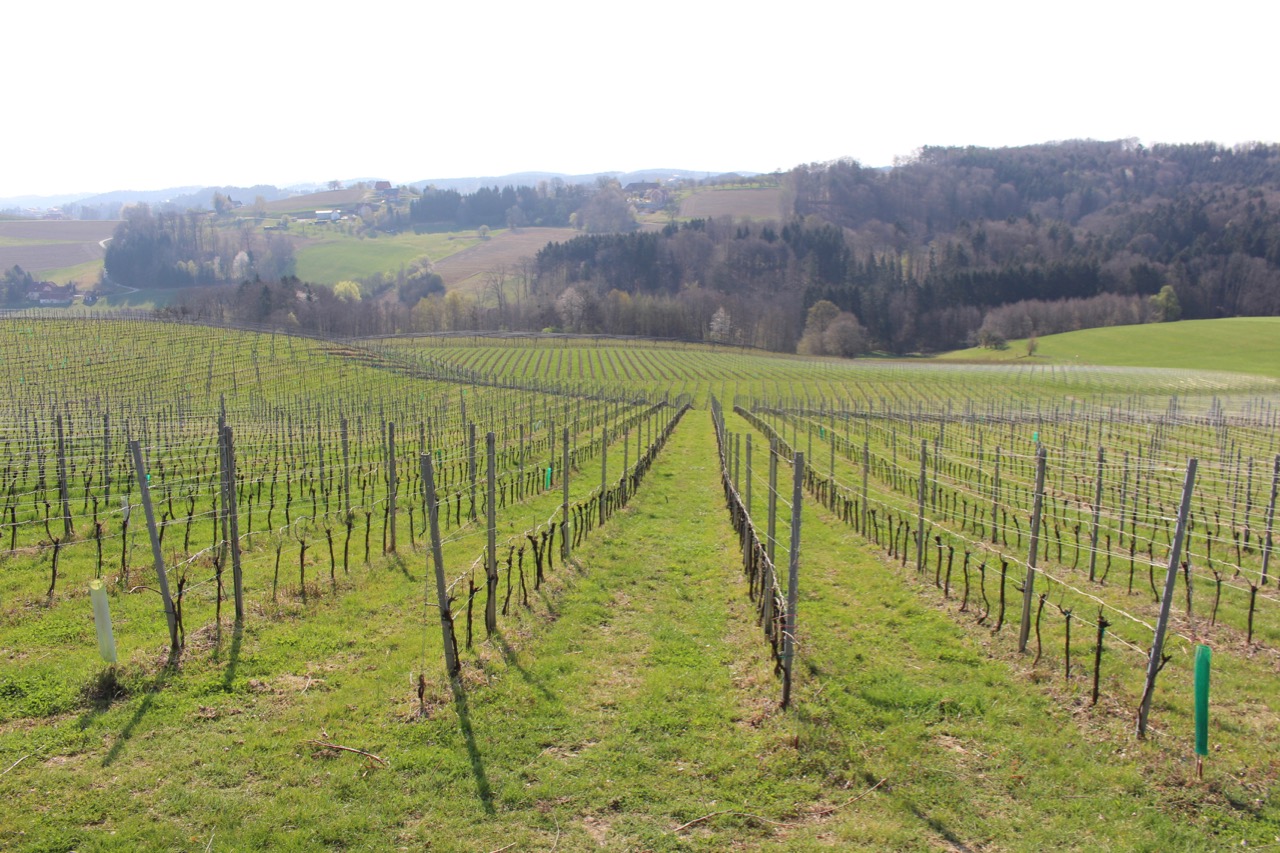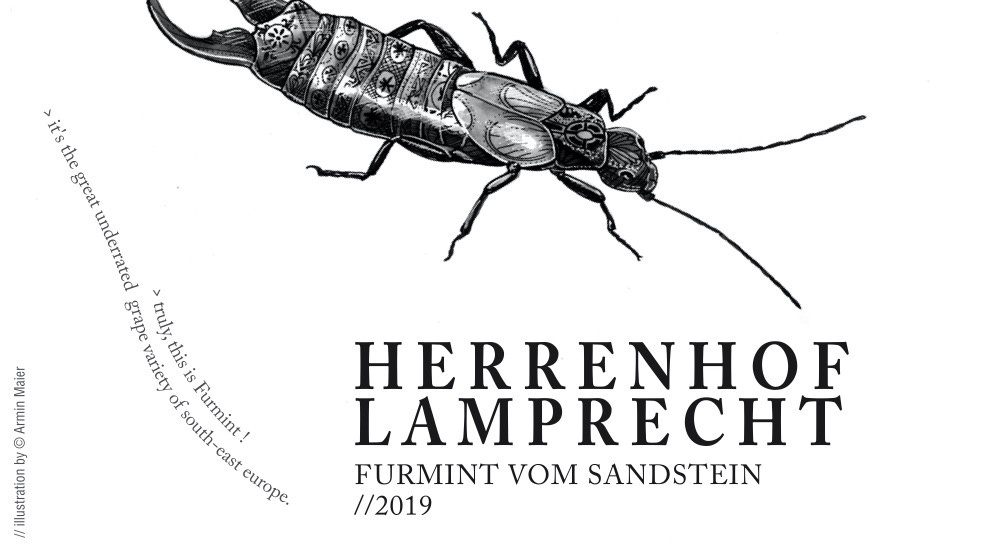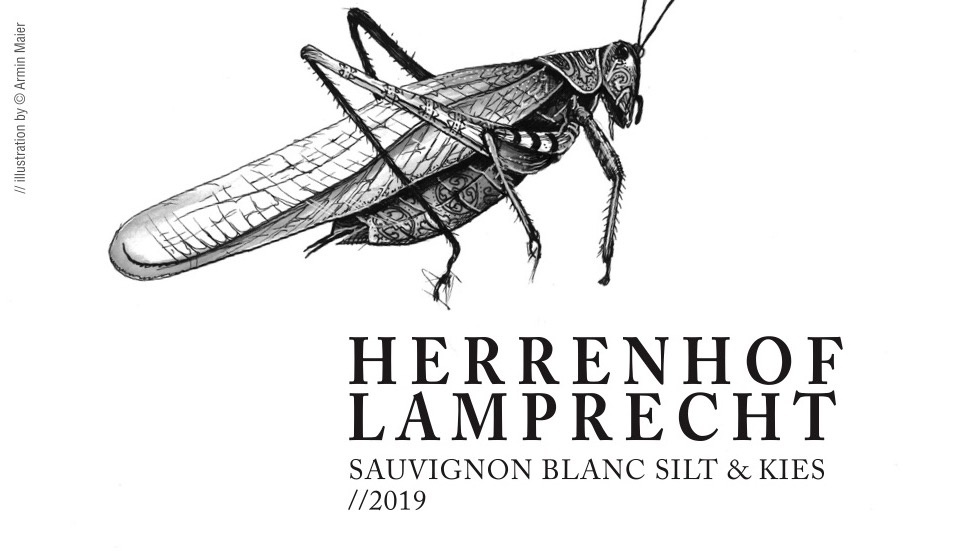

Herrenhof Lamprecht, Vulkanland, Austria
Artisan handcrafted wines & no compromises

At a Glance
https://www.herrenhof.net
Vulkanland
Continental (hot summers & cold winters)
Weathered sandstone, silt, gravel, clay and marl
350m
Volcanic hillsides
Red and white field blends including Pinot Blanc, Sauvignon Blanc, Welschriesling, Pinot Grigio, Furmint, Blaufränkisch, St Laurent, Kadarka, Pinot Noir and Blauer Wildbacher
9 hectares
Certified Organic
Natural
Vulkanland
Continental (hot summers & cold winters)
Weathered sandstone, silt, gravel, clay and marl
350m
Volcanic hillsides
Red and white field blends including Pinot Blanc, Sauvignon Blanc, Welschriesling, Pinot Grigio, Furmint, Blaufränkisch, St Laurent, Kadarka, Pinot Noir and Blauer Wildbacher
9 hectares
Certified Organic
Natural

Gottfried and Eric in front of the winery
Gottfried is very paced, formal, and soft-spoken on first impression. Then you see his art that adorns the cellar. My favorite is an explosion of color with “I am on fire” written in bold. Then you head out to the vineyard where he’s planted to over a 100 different grapes from scratch with a philosophy of “freestyle wine growing” and following his own self imposed Charta. Then you taste his red and white field blends and bringing historical grapes like Furmint back into the fold and they are in indeed also on fire. He is exponentially more than his initial impression and we are proud to be importing these into the US for the very first time with this shipment.

Drinking with Gottfried Lamprecht
The People
The Lamprecht family owns what was once the Vorau Abbey until it closed at the end or the 19th Century as feudal law and many other politics changed. The monks did grow vineyards on the same slopes, but the land has been without grapes for many decades. In 2006 Gottfried started planting block by block until reaching 9 hectares and has been certified organic from the start. He studied horticulture at the University of Vienna, but is more guided by the field blend tradition that was lost in the appellation as opposed to making pure mono varietal wines that is far more prevalent. Being able to start from scratch and control every element himself is what makes this producer special apart from the wines being delicious of course.

Early spring looking down the Buchertberg
Vineyards
Gottfried is not without a dry sense of humor. He labels his wines grown on his own Buchertberg hill as “ABC” (Appellation Buchertberg Contrôlée). The soil here is mostly weathered sandstone, silt, gravel, and “opok” (clay, marl). The reds prefer the opok while the whites thrive in the sand and gravel.

Buchertberg Terroir
Given the official Vulkanland Appellation, there is volcanic activity (basalt) as well, but not dominant. As mentioned, he has been organic since 2007 and keeps his yield at or less than 45 hl/ha.

Appellation Buchertberg Contrôllée
Cover crops are wild and the place is buzzing. The Pannonian climate is similar to southern Burgenland, but overall PH is typically lower. What really sets Gottfried apart is the extensive field blend. Here is a list of what’s currently planted:
Adelfränkisch, Affenthaler, Augster Gelber, Auxerrois, Bettlertraube, Blaue Frankentraube, Blauelbling, Blauer Arbst, Blauer Elbling, Blauer Hängling, Blauer Sylvaner, Blauer Wildbacher, Blaukölner, Bouquet-Silvaner, Bourguignon, Elbling, Frühburgunder, Frühe Magyartraube, Furmint, Gelber Langstieler, Gelber Traminer, Gewürztraminer, Goldriesling, Grauburgunder, Grüner Sylvaner, Grüner Veltliner, Grünfränkisch, Hartblau, Heunisch Rotgestreift, Heunisch Schwarz, Honigler, Jubiläumsrebe, Kleinberger Kerner, Kleinedel, Kleiner Burgunder, Morillion, Muskat-Gutedel, Muskateller, Neuburger, Ortlieber, Peloursin, Pinot Meunier, Pinot Noir, Piros Furmint, Riesling, Roter Elbling, Roter Gutedel, Roter Hänisch/Pamid, Roter Heunisch, Roter Traminer, Roter Veltliner, Rotgipfler, Sauvignon Blanc, Scheurebe, Schlehentrauben, Schwarzurban, Süßschwarz, Tauberschwarz, Trollinger, Weissburgunder, Weiße Orleans, Weisser Gutedel, Weißer Heunisch, Weißer Kadarka, Weißer Lagler, Weißer Räuschling, Weißer Tokayer, Weißer Veltliner, Welschriesling, Zierfandler, and even some Zinfandel.

Buchertberg Terroir
Given the official Vulkanland Appellation, there is volcanic activity (basalt) as well, but not dominant. As mentioned, he has been organic since 2007 and keeps his yield at or less than 45 hl/ha.

Appellation Buchertberg Contrôllée
Cover crops are wild and the place is buzzing. The Pannonian climate is similar to southern Burgenland, but overall PH is typically lower. What really sets Gottfried apart is the extensive field blend. Here is a list of what’s currently planted:
Adelfränkisch, Affenthaler, Augster Gelber, Auxerrois, Bettlertraube, Blaue Frankentraube, Blauelbling, Blauer Arbst, Blauer Elbling, Blauer Hängling, Blauer Sylvaner, Blauer Wildbacher, Blaukölner, Bouquet-Silvaner, Bourguignon, Elbling, Frühburgunder, Frühe Magyartraube, Furmint, Gelber Langstieler, Gelber Traminer, Gewürztraminer, Goldriesling, Grauburgunder, Grüner Sylvaner, Grüner Veltliner, Grünfränkisch, Hartblau, Heunisch Rotgestreift, Heunisch Schwarz, Honigler, Jubiläumsrebe, Kleinberger Kerner, Kleinedel, Kleiner Burgunder, Morillion, Muskat-Gutedel, Muskateller, Neuburger, Ortlieber, Peloursin, Pinot Meunier, Pinot Noir, Piros Furmint, Riesling, Roter Elbling, Roter Gutedel, Roter Hänisch/Pamid, Roter Heunisch, Roter Traminer, Roter Veltliner, Rotgipfler, Sauvignon Blanc, Scheurebe, Schlehentrauben, Schwarzurban, Süßschwarz, Tauberschwarz, Trollinger, Weissburgunder, Weiße Orleans, Weisser Gutedel, Weißer Heunisch, Weißer Kadarka, Weißer Lagler, Weißer Räuschling, Weißer Tokayer, Weißer Veltliner, Welschriesling, Zierfandler, and even some Zinfandel.

Gottfriend in the cellar
Winemaking
The winemaking is fairly simple. Most wines are destemmed and crushed. He avoids being overly phenolic, so there’s very little forced extraction or lengthy skin contact. Typical maceration is between 36-40 hours. All fermentation is spontaneous, he uses used 300L to 600L oak (40% coopered locally), and extended lees aging is key (9-18 months). The only addition is SO2 at bottling, usually around 20ppm total.

Red Wine , Organic
various;
12.6%
0.1 g/l
6.2 g/l
various;
12.6%
0.1 g/l
6.2 g/l
While not as diverse in terms of grapes as the white, the Blaufränkisch is dominant with lesser amounts of St Laurent, Kadarka, Pinot Noir and Blauer Wildbacher backing it up. Everything is crushed together, about 5% stem inclusion, about 40 hours of maceration, and full malo in barrel. Lighter bodied than a typical Burgenland red, but with more spice, acidity and lift. A unique red in the portfolio.

Red Wine , Organic
various;
12%
0.2 g/l
6.9 g/l
various;
12%
0.2 g/l
6.9 g/l
While not as diverse in terms of grapes as the white, the Blaufränkisch is dominant with lesser amounts of St Laurent, Kadarka, Pinot Noir and Blauer Wildbacher backing it up. Everything is crushed together, about 5% stem inclusion, about 40 hours of maceration, and full malo in barrel. Lighter bodied than a typical Burgenland red, but with more spice, acidity and lift. A unique red in the portfolio.

White Wine , Organic
various;
12.6%
0.2 g/l
5.5 g/l
various;
12.6%
0.2 g/l
5.5 g/l
There are over a 100 different grapes in this wine from one hill. It’s an aggressive field blend to be sure, but with an agenda to champion the Gemischter Satz that was once the norm here. There are of course some dominant grapes like Pinot Blanc, Sauvignon Blanc, Welschriesling, Pinot Grigio, and Furmint, but as this wine is open and ages, the onion begins to peel. Everything is hand harvested, co-fermented, light maceration (12-36 hours) without temperature control, then left on the lees in barrel for 1.5 years. Bottled unfined and unfiltered, the only addition is SO2 (~15-20 ppm).

White Wine , Organic
Furmint;
11.6%
0.2 g/l
6.1 g/l
Furmint;
11.6%
0.2 g/l
6.1 g/l
Planted back in 2010, this was once a very important grape in the region known as Mosler. Although largely lost due to Phylloxera, it’s markets cut off due to the Iron Curtain, and the decline of traditional field blends (Gemischter Satz), this grape persists here due to a handful of growers like Gottfried. It’s also ideally suited for climate change. After a relatively short maceration (12-36 hours), it’s then fermented and aged in 600L oak barrels for one year. The limy sandstone and lack of botrytis both offer something completely new as opposed to the volcanic ridden soils of Somló and Tokaj. The aromatics are jumpy without being forced, the texture is smooth despite zero residual sugar, and there’s simply a lot packed into a sub 12% alcohol package.

White Wine , Organic
Furmint;
12.6%
1.5 g/l
5.6 g/l
Furmint;
12.6%
1.5 g/l
5.6 g/l
Traditionally referred to as the „Austria-Magnum,” this 2 liter bottle reminds Gottfried of seeing Massive Attack live at Novarock. This is festival wine. Furmint was once a very important grape in the region known as Mosler. Largely lost due to Phylloxera, the Iron Curtain, and the decline of traditional field blends, this grape persists here thanks to a handful of growers like Gottfried. It’s also ideally suited for climate change. After a relatively short maceration (12-36 hours), it’s then fermented and aged in 600L oak barrels for one year. The limy sandstone and lack of botrytis both offer something completely new as opposed to the volcanic ridden soils of Somló and Tokaj.

White Wine , Organic
Pinot Blanc;
12.7%
0.5 g/l
5.7 g/l
Pinot Blanc;
12.7%
0.5 g/l
5.7 g/l
The Sand and Kalk Pinot Blanc is as Gottfried puts it, “our entry drug.” The grape is ideally suited to the calcareous (kalk) and sandstone soils and after a short 12-36 hours on the skins, it’s fermented in 600L oak barrels coopered exclusively from the forest next to the Buchertberg and aged one year on the lees. The levity and energy of this wine brings us back to eating fresh salads and braised pork smothered in pumpkin seed oil and freshly grated horseradish at the estate. Bottled unfiltered with low SO2, it’s best when given air and allowed to come up a bit in temperature – an ideal BTG quality.

Red Wine , Organic
Pinot Noir;
12.7%
0.2 g/l
6 g/l
Pinot Noir;
12.7%
0.2 g/l
6 g/l
Sourced from vines growing on fine-grained sediments known as "Opok" in the Styria region. Fermented spontaneously using low-intervention. Unfined and Unfiltered.

White Wine , Organic
Sauvignon Blanc;
12.5%
2.3 g/l
6 g/l
Sauvignon Blanc;
12.5%
2.3 g/l
6 g/l
The 2019 Silt and Gravels, as the soil imply, retains a lot of heat that takes the often overpowering greenness of the grape out of the picture. A full day of maceration in 300L neutral French, Hungarian, and Styrian oak barrels also adds some structure to the ever present salty sweet acidity of the estate. The only addition is a small amount of SO2 at bottling (10-15ppm). This is a wine that reminds me not to poo-poo this grape based on my view of the market and instead use it as a new lens to better understand and enjoy this place.